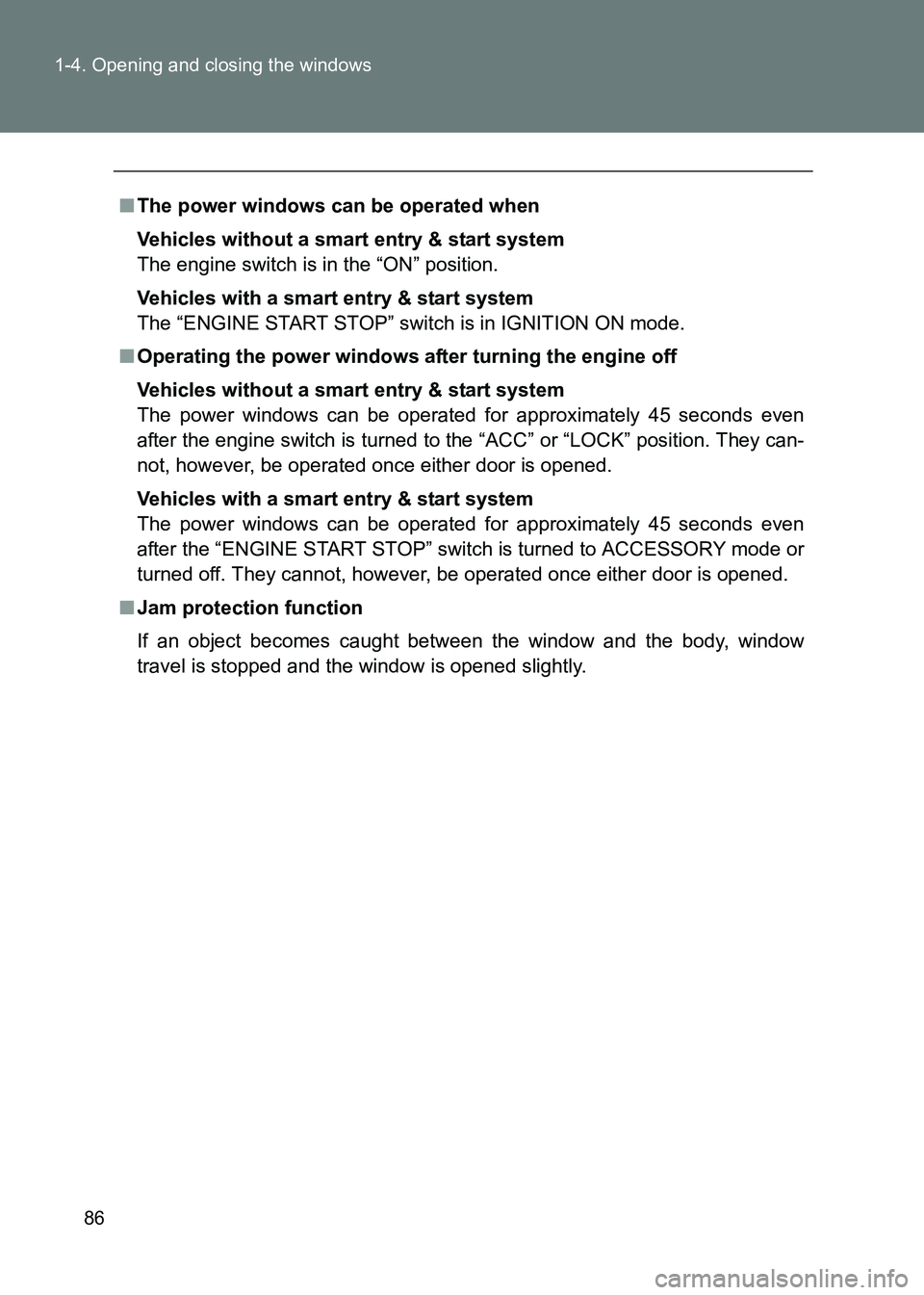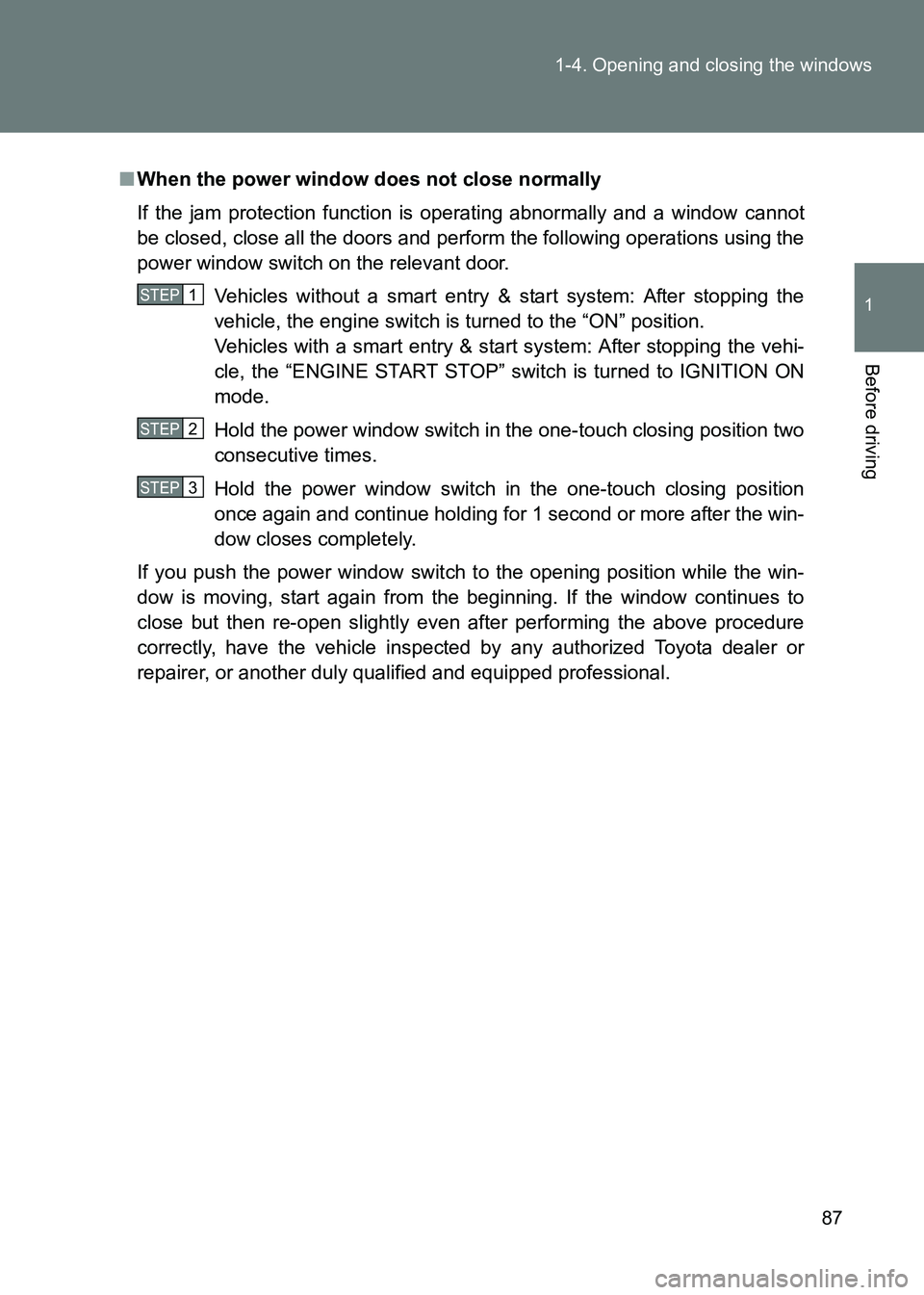Page 86 of 505

86
1-4. Opening and closing the windows
86_EE (OM18071E)
■
The power windows can be operated when
Vehicles without a smart entry & start system
The engine switch is in the “ON” position.
Vehicles with a smart entry & start system
The “ENGINE START STOP” switch is in IGNITION ON mode.
■ Operating the power windows after turning the engine off
Vehicles without a smart entry & start system
The power windows can be operated for approximately 45 seconds even
after the engine switch is turned to the “ACC” or “LOCK” position. They can-
not, however, be operated once either door is opened.
Vehicles with a smart entry & start system
The power windows can be operated for approximately 45 seconds even
after the “ENGINE START STOP” switch is turned to ACCESSORY mode or
turned off. They cannot, however, be operated once either door is opened.
■ Jam protection function
If an object becomes caught between the window and the body, window
travel is stopped and the window is opened slightly.
Page 87 of 505

87
1-4. Opening and closing the windows
1
Before driving
86_EE (OM18071E)
■
When the power window does not close normally
If the jam protection function is operating abnormally and a window cannot
be closed, close all the doors and perform the following operations using the
power window switch on the relevant door.
Vehicles without a smart entry & start system: After stopping the
vehicle, the engine switch is turned to the “ON” position.
Vehicles with a smart entry & st art system: After stopping the vehi-
cle, the “ENGINE START STOP” switch is turned to IGNITION ON
mode.
Hold the power window switch in the one-touch closing position two
consecutive times.
Hold the power window switch in the one-touch closing position
once again and continue holding for 1 second or more after the win-
dow closes completely.
If you push the power window switch to the opening position while the win-
dow is moving, start again from the beginning. If the window continues to
close but then re-open slightly even after performing the above procedure
correctly, have the vehicle inspected by any authorized Toyota dealer or
repairer, or another duly qualified and equipped professional.
STEP 1
STEP 2
STEP 3
Page 88 of 505

88
1-4. Opening and closing the windows
86_EE (OM18071E)
WARNING
■
Closing the windows
Observe the following precautions.
Failure to do so may result in death or serious injury.
●The driver is responsible for all t he power window operations, including the
operation for the passengers. In order to prevent accidental operation,
especially by a child, do not let a child operate the power windows. It is
possible for children and other passengers to have body parts caught in
the power window. Also, when riding with a child, it is recommended to use
the window lock switch. ( →P. 85)
● Check to make sure that all passengers do not have any part of their body
in a position where it could be caught when a window is being operated.
● When exiting the vehicle, turn the engi ne switch (vehicles without a smart
entry & start system) or the “ENGINE START STOP” switch (vehicles with
a smart entry & start system) off, carry the key and exit the vehicle along
with the child. There may be accidental operation, due to mischief, etc.,
that may possibly lead to an accident.
■ Jam protection function
●Never use any part of your body to intentionally activate the jam protection
function.
● The jam protection function may not work if something gets caught just
before the window fully closes.
Page 89 of 505
89
1
Before driving
86_EE (OM18071E)
1-5. Refueling
Opening the fuel tank cap
Perform the following steps to open the fuel tank cap:
■Before refueling the vehicle
●Vehicles without a smart entry & start system: Turn the engine
switch off and ensure that all the doors and windows are
closed.
● Vehicles with a smart entry & start system: Turn the “ENGINE
START STOP” switch off and ensure that all the doors and
windows are closed.
● Confirm the type of fuel. ( →P. 9 0 )
■ Opening the fuel tank cap
Pull up the opener to open the
fuel filler door.
Turn the fuel tank cap slowly
to open.
STEP 1
STEP 2
Page 93 of 505
93
1
Before driving
86_EE (OM18071E)
1-6. Theft deterrent system
Engine immobilizer system
The vehicle's keys have built-in transponder chips that prevent the
engine from starting if the key has not been previously registered in
the vehicle's on-board computer.
Never leave the keys inside the vehicle when you leave the vehicle.
This system is designed to help prevent vehicle theft but does not
guarantee absolute security against all vehicle thefts.
Vehicles without a smart
entry & start system
The indicator light flashes after
the key has been removed
from the engine switch to indi-
cate that the system is operat-
ing.
The indicator light stops flash-
ing after the registered key
has been inserted into the
engine switch to indicate that
the system has been can-
celed.
Page 94 of 505
94
1-6. Theft deterrent system
86_EE (OM18071E)
■
When the vehicle cannot be started with the registered key (vehicles
without a smart entry & start system)
Remove the key and try again.
■System maintenance
The vehicle has a maintenance-free type engine immobilizer system.
■ Conditions that may cause the system to malfunction
●If the key is in contact with a metallic object
● If the key is in close proximity to or touching a key to the security system
(key with a built-in transponder chip) of another vehicle
Vehicles with a smart entry
& start system
The indicator light flashes after
the “ENGINE START STOP”
switch has been turned off to
indicate that the system is
operating.
The indicator light stops flash-
ing after the “ENGINE START
STOP” switch has been turned
to ACCESSORY or IGNITION
ON mode to indicate that the
system has been canceled.
Page 102 of 505
102
1-6. Theft deterrent system
86_EE (OM18071E)
Double locking system∗
Setting the double locking systemVehicles without a smart entry & start system: Turn the engine switch
off, have all the passengers exit the vehicle and ensure that all the
doors are closed.
Vehicles with a smart entry & start system: Turn the “ENGINE START
STOP” switch off, have all the passengers exit the vehicle and ensure
that all the doors are closed.
Using the entry function (vehicles with a smart entry & start system):
Press the lock button on the outside door handle.
Using the wireless remote control:
Press .
∗: If equipped
Unauthorized access to the vehicle is prevented by disabling the
door unlocking function from both the interior and exterior of the
vehicle.
Vehicles employing this sys-
tem have labels on the win-
dow glass of both front doors.
Page 116 of 505

116
1-7. Safety information
86_EE (OM18071E)
The SRS airbag can function only when the engine switch is in the “ON”
position (vehicles without a smart entry & start system) or when the
“ENGINE START STOP” switch is in IGNITION ON mode (vehicles with a
smart entry & start system).
If the front sub sensors located on both the right and left sides at the front of
the vehicle and the impact sensors in the airbag control module detect a cer-
tain predetermined amount of force during a front collision, the control mod-
ule sends signals to the front airbag modules instructing them to inflate the
SRS front airbags. Then both airbag modules produce gas, which instantly
inflates driver’s and passenger’s SRS front airbags. The knee airbag is also
inflated in combination with the SRS front airbags.
After deployment, the SRS airbags immediately start to deflate so that the
driver’s vision is not obstructed. The time required from detecting impact to
the deflation of the SRS airbag after deployment is shorter than the blink of
an eye.
Although it is highly unlikely that the SRS airbag would activate in a non-
accident situation, should it occur, the SRS airbag will deflate quickly, not
obscuring vision and will not interfere with the driver's ability to maintain con-
trol of the vehicle.
When the SRS airbag deploys, a sudden, fairly loud inflation noise will be
heard and some smoke will be released. These occurrences are normal
result of the deployment. This smoke does not indicate a fire in the vehicle.